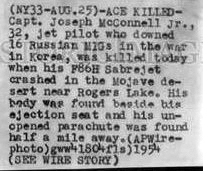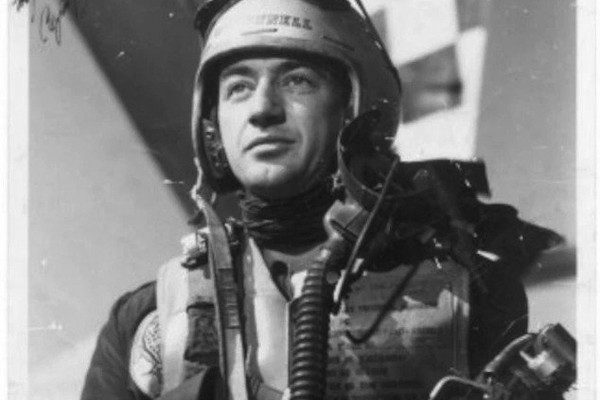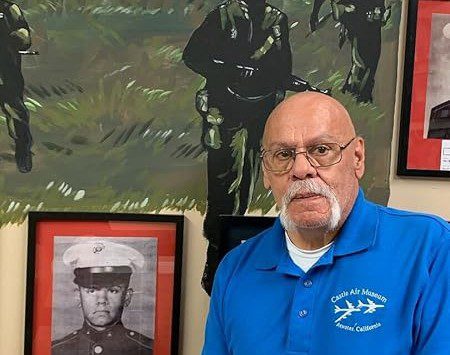Looking back from our vantage point here in 2021, we see the dynamics of both fighter pilots and test pilots changing, as many aspects of technology have changed the way new generations view the pilots of today. Sure, we admire and celebrate those individuals who strap into the aircraft that spark our imaginations, and we marvel at the skills they bring to their craft, but something is changing; or, should I say, has changed.
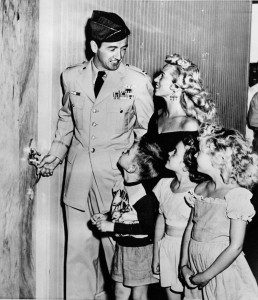
Over my life, I have attended many programs, air shows, reunions, and museums. I’ve been a member of many groups of combat veterans who had their experiences test flying or flying in combat and seemed to always want to hold on to the glory years of service that defined their lives. Needless to say, that society also celebrated in a different manner how we viewed the pilots of those eras; fans were never in short supply when one of those old legends made a public appearance.
What got me thinking about this change came about via an old ‘gate guard’ that for years when I was at George Air Force Base, was just a backdrop to my everyday work schedule. It was an old F-86 up on blocks, sitting just west of the headquarters building. With the name “Beauteous Butch” painted under the cockpit, I just figured it had some historical lineage that was connected to the base or the local community. I never really researched it until years later when I had a chance encounter with that same aircraft when it was moved to the Apple Valley Airport. Now I was curious, as it must surely have a local connection. When I dug in deep, I was stunned to see the story unfold that ended up at Edwards AFB with a tragic flight in 1954, and how a beloved member of a community was treated back in the days when a heroic hometown fighter pilot was bigger than any celebrity of the time period.
Capt. Joseph Christopher McConnell Jr. was more than just another fighter pilot; he was one of the all-time greats. He was the only Triple Ace to come out of the Korean War and the only Triple Ace of the jet age, as all his victories were against jet aircraft. This is an amazing statistic that was achieved after a year of flying combat in Korea where he had not shot down one enemy aircraft, followed by a period when he scored all of his victories during a four-month span from Jan. 14 to May 18, 1953. To say he was a driven man would be an understatement, as his desire to mix it up was legendary. After one mission when his F-86 had been mortally wounded, he still managed to maneuver it and gain a victory by shooting down the MiG that had basically shot him down. As he slowly lost control of his Sabre, he ejected over the Yellow Sea and was later picked up by helicopters and returned to his base; where the very next day he was back at it mixing it up with the bad guys. On one mission he shot down three MiGs in one day. Totaling up 16 victories, there came a call that said it was time for the hot pilot to come home before the odds caught up to him. He came home and was whisked off to Washington where President Eisenhower, in a lavish event at the White House, paid tribute to his accomplishment by awarding Captain McConnell the Distinguished Service Cross for his actions on May 18, 1953.

The Citation read:
“The President of the United States of America, under the provisions of the Act of Congress approved July 9, 1918, takes pleasure in presenting the Distinguished Service Cross to Captain Joseph McConnell Jr., United States Air Force, for extraordinary heroism in connection with military operations against an armed enemy of the United Nations while serving as a Pilot with the 39th Fighter-Interceptor Squadron, 51st Fighter-Interceptor Wing, FIFTH Air Force, in action against enemy forces in the Republic of Korea on 18 May 1953. Leading two F-86s on an air superiority mission over North Korea, he sighted a formation of twenty-eight MIG-15 type aircraft. Determined to accomplish his mission and with complete disregard for the numerical odds against him, he immediately attacked. Although under fire himself, he pressed his attack to such extent that he completely disorganized the enemy formation, destroying one of the MIGs and damaging another. Several enemy aircraft were then firing at him but, seeing that the other Sabre in his flight was also being fired upon, he completely ignored enemy cannon fire directed at himself and destroyed the MIG that was pursuing his wingman. These victories, in spite of counterattacks by such superior numbers, completely unnerved the enemy to the extent that they withdrew across the Yalu before further attacks could be made. Through his courage, keen flying ability, and devotion to duty, Captain McConnell reflected great credit upon himself, the Far East Air Forces, and the United States Air Force.”
So we now see that the captain was a really big deal and, for the time, a household name. Over time the gloss fades away, but to the citizens of his hometown Apple Valley, their love for him was never-ending; so much so that the community not only built him a complete house for his family but the local community and businesses paid for it all and the house, from dirt to completion, was done in just four days! When it was completed, the Apple Valley Fire Department rang the station bell, and a parade formed, as the community escorted Captain McConnell and his family to their new home.
Tragedy, however, was just around the corner as the captain, who was doing most of his flying out of George AFB, was now involved with flight testing the new F-86H at Edwards AFB. On Aug. 25, 1954, while testing the fifth production F-86H-1-NA (serial number 52-1981) at Edwards, McConnell was killed in a crash near the base following a control malfunction. The cause of the accident was attributed to a missing bolt. Then-Maj. Chuck Yeager was assigned to investigate the crash and replicated the malfunction at a much higher altitude. The “H” that he was testing had a complete hydraulic failure. Captain Mac, relying on his experience in Korea where he had practiced landing with just throttle and rudder many times, tried this technique during the ill-fated flight. It almost worked, but ground turbulence lifted up a wing. He ejected but was far too close to the ground. In less than a year from his being handed the keys to his new home, he was gone, leaving a community that mourned his loss. The beloved son of Apple Valley would no longer be the friendly face greeted on the streets of the High Desert by fans, young and old alike.
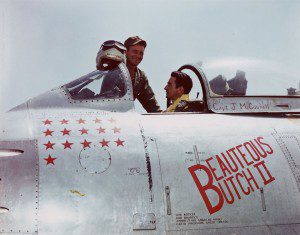
Beauteous Butch, the mount of a Korean War legend, was named after McConnell’s wife, whose nickname was Butch. For many years it stood as a reminder of a different time and a different kind of pilot. It was looked upon by a community that held these men and events close to their hearts, as they inspired them just like any serial superhero in comic books or Saturday morning cartoons and programs. Thus, these are the people over the last decades who always felt a connection to these generations of pilots and their accomplishments, seeking them out at gatherings and events to share their admiration for their bravery and skill.
Now an old jet sits at an airport with a plaque, the words do not do it justice, and I’m sure some people make the journey to the cemetery in Victorville on Veterans or Memorial Day and pay respects to an American legend who achieved a greatness that will never be duplicated in modern warfare. There was a time when all this black and white was lived in color and with the passage of time, these things tend to fade to gray. We must hope that historians and storytellers will somehow find the way to bridge generations and spark the imagination with the words and pictures that will instill a passion and bring back the heroes of yesterday. These stories motivate, inspire and put the color back in the service and sacrifice of our history’s heroes; a color that serves to push back against the gray shadows of today.
Beauteous Butch now has a story and Capt. Joseph “Mac” McConnell Jr. will now be introduced to a new generation via this story. We hope he and his exploits carry on beyond this page and an old jet behind a fence will shine a little brighter.
Until next time, Bob out!

